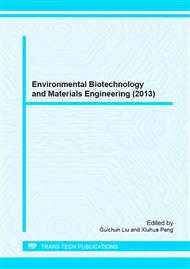[1]
O.H. Annalisa, Z.G. April. Comparisons of organic sources for denitrification: Biodegradability, denitrification rates, kinetic constants and practical implication for their application in WWTPs. Water Environment Federation. (2008) 253-274.
DOI: 10.2175/193864708788735510
Google Scholar
[2]
D. Bolzonella, L. Innocenti, P. Pavan. et al. Denitrification potential enhancement by addition of anaerobic fermentation products from the organic fraction of municipal solid waste. Water Science and Technology, 44(1) (2001) 187-194.
DOI: 10.2166/wst.2001.0046
Google Scholar
[3]
A. Bouzas, C. Gabaldon, P. Marzal, et al. Fermentation of municipal primary sludge: effect of SRT and solid concentration on volatile fatty acid production. 13 (2002) 863-875.
DOI: 10.1080/09593332308618359
Google Scholar
[4]
C.Y. Lee, H.S. Shin. et al. Nutrient removal using anaerobically fermented leachate of food waste in the BNR process. Water Science and Technology, 47(1) (2002) 159-165.
DOI: 10.2166/wst.2003.0042
Google Scholar
[5]
Z.X. Quan Y.S. Jin C.R. Yin. Hydrolyzed molasses as an external carbon source in biological nitrogen removal. Bioresource Technology, 96 (2005) 1690-1695.
DOI: 10.1016/j.biortech.2004.12.033
Google Scholar
[6]
L. Rodrı´guez, J. Villasenor. et al. Re-use of winery wastewaters for biological nutrient removal. Water Science & Technology. 56(2) (2007) 95-102.
DOI: 10.2166/wst.2007.477
Google Scholar
[7]
American Public Health Association (APHA), American Water Works Association(AWWA), Water Environment Federation (WEF), Standard methods for the examination of water and wastewater, 20th ed., Washington, DC: American Public Health Association, (1998).
DOI: 10.1002/j.1551-8833.1932.tb18153.x
Google Scholar
[8]
O.H. Lowry, N.J. Rosebrough, A.L. Farr, R.J. Randall, Protein measurement withthe Folin phenol reagent, J. Biol. Chem. 193 (1951) 165-175.
DOI: 10.1016/s0021-9258(19)52451-6
Google Scholar
[9]
D. Herbert, P.J. Philipps, R.E. Strange, Methods Enzymol. 5B (1971) 265-277.
Google Scholar
[10]
A. Onnis, A. Carucci & G. Cappai. Titration biosensors for the estimation of the biochemical nitrate demand of municipal and industrial wastes. Journal of Industrial Microbiology &Biotechnology, 33 (2006) 243-246.
DOI: 10.1007/s10295-005-0221-6
Google Scholar
[11]
M. Sage, G. Daufin & G. Gesan-Guiziou. Denitrification potential and rates of complex carbon source from dairy effluents in activated sludge system. Water Research, 40(14) (2006) 2747-2755.
DOI: 10.1016/j.watres.2006.04.005
Google Scholar
[12]
N. Bernet, F. Habouzit & R. Moletta. Use of an industrial effluent as a carbon source for denitrification of a high-strength wastewater, Applied Microbiology and Biotechnology. 46(1) (1996) 92-97.
DOI: 10.1007/s002530050788
Google Scholar
[13]
Y. Mokhayeri, A. Nichols, S. Murthy, et al. Examining the influence of substrates and temperature on maximum specific growth rate of denitrifiers. Water Science and Technology, 54(8) (2006) 155-162.
DOI: 10.2166/wst.2006.854
Google Scholar
[14]
M. Prentice, Sweetening up the Process: Experience with corn syrup for enhanced denitrification at the Henrico County WRF. 2nd External Carbon Source WERF. Washington, DC. (2007).
DOI: 10.2175/193864707786862071
Google Scholar
[15]
G. Cappai, A. Carucci, A. Onnis. Use of industrial wastewaters for the optimization and control of nitrogen removal processes. Water Science and Technology, 50(6) (2004), 17-24.
DOI: 10.2166/wst.2004.0354
Google Scholar
[16]
P. Kampas, S.A. Parsons, P. Pearce, et al. An internal carbon source for improving biological nutrient removal. Bioresource Technology, 100 (2009) 149–154.
DOI: 10.1016/j.biortech.2008.05.023
Google Scholar
[17]
A. Soaresa, P. Kampasa, S. Maillard, et al. Comparison between disintegrated and fermented sewage sludge for production of a carbon source suitable for biological nutrient removal. Journal of Hazardous Materials, 175 (2010) 733–739.
DOI: 10.1016/j.jhazmat.2009.10.070
Google Scholar
[18]
P. Elefsiniotis, D.G. Wareham, M.O. Smith, Use of volatile fatty acids from an acid-phase digester for denitrification. Journal of Biotechnology, 114 (2004) 289–297.
DOI: 10.1016/j.jbiotec.2004.02.016
Google Scholar
[19]
H.J. Lee, J.H. Bae, K.M. Cho, Simultaneous nitrification and denitrification in a mixed methanotrophic culture. Biotechnology Letters, 23(12) (2001) 935-941.
Google Scholar
[20]
A.A. Raghoebarsing, A. Pol, et al. A microbial consortium couples anaerobic methane oxidation to denitrification. Nature, 440 (2006) 918-921.
DOI: 10.1038/nature04617
Google Scholar
[21]
J.W. Lee, U.J. Yoo, T.H. Chung, Assessment of the availability of organic wastes as an external carbon source for denitrification. Environ. Eng. Res. 5 (2000) 193-198.
Google Scholar
[22]
Y. Chen, A.A. Randall, T. McCue, The efficiency of enhanced biological phosphorus removal from real wastewater affected by different ratios of acetic to propionic acid. Water Res. 38 (2004) 27–36.
DOI: 10.1016/j.watres.2003.08.025
Google Scholar
[23]
Z.H. Abu-ghararah, C.W. Randall, The effect of organic compounds on biological phosphorus removal. Water Science and Technology. 23 (1991) 585–594.
DOI: 10.2166/wst.1991.0508
Google Scholar
[24]
A. Gerber, E. S Mostert, C. T Winter et al. The effect of acetate and other short-chain carbon compound on the kinetics of biological nutrient removal. Water SA. 12 (1986).
Google Scholar
[25]
D. Kulikowska. Nitrogen removal from landfill leachate via the nitrite route. Brazilian Journal of Chemical Engineering. 29 (2012) 211-219.
DOI: 10.1590/s0104-66322012000200002
Google Scholar


